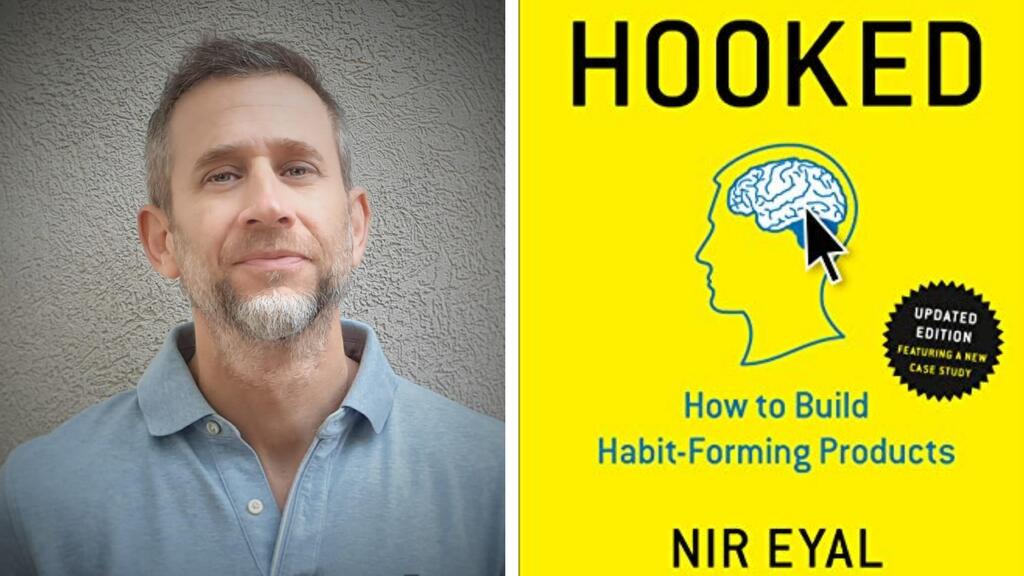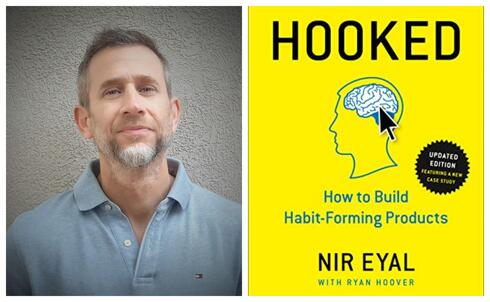
BiblioTech
CTech's Book Review: The four steps to building “habit-forming products”
Asaf Ronat, VP of Product at Pixellot, has joined CTech to share a review of “Hooked: How to Build Habit-Forming Products” by Nir Eyal
Asaf Ronat is the VP of Product at Pixellot, an Israeli automated AI-based sports production technology company. He has joined CTech to share a review of “Hooked: How to Build Habit-Forming Products” by Nir Eyal
Title: “Hooked: How to Build Habit-Forming Products”
Author: Nir Eyal
Format: Tablet
Where: Home
Summary:
In a nutshell, "Hooked" by Nir Eyal, as the name implies, provides the know-how on how to make users re-engage again and again with the product. The philosophy, practical tools, and examples presented in the book are based on an analysis of successful products like LinkedIn, the iPhone, Google, Twitter, Pinterest, and more.
What drives us to check our phone first thing when we wake up? Why do we open Waze (a navigator) automatically on each drive although we know the direction?
It discusses how to move the needle from "just" providing value that the user enjoys, to the notion of finding a way to generate a new "habit" for the user. A "habit" is a mental state in which we spend most of our waking hours. We don’t actively think about walking, breathing, driving... When we are on autopilot, we are more susceptible to habit. By transitioning to habits, we affect customer behavior "behind the screens", without depending on costly advertising, marketing, and aggressive messaging. A habit by definition causes more frequent usage which means viral growth, more frequent usage, and sharing of a product. This enables the product’s adoption to grow exponentially. In addition, once using a product has become ingrained in the user’s behavior, it is easier to increase its price because the user might perceive shifting to a new product as an annoying task. How many customers would switch from an iPhone to an Android phone just for the price?
The book was praised by many well-known entrepreneurs such as Eric Ries (The Lean Startup), Dave McClure (500 Startups), and Boris Veldhuijzen van Zanten (The Next Web).
Important Themes:
"Habit-forming products" target to change user behavior and create unprompted engagement, to influence customers to use the product or service, over and over, without relying on external influence as ads, promotions, etc. The four steps to building “habit-forming products”: Trigger, Action, Variable Reward, and Investment. I would summarize each:
1. Trigger
Triggers engage our brains in performing a behavior. There are two types of triggers: external and internal. External triggers are easy to identify. They come in the form of text notifications, emails, etc. with a call to action. Internal triggers are harder to identify because they reside in the user’s mind. Using internal triggers requires a much deeper understanding of users’ motivations. Many internal triggers are associated with negative emotional states such as fear, boredom, and FOMO (Fear of Missing Out). Our urge to open a post on social networks every few minutes, probably to check who "liked" our post, who commented on it, and how many, is a good example of an internal trigger.
2. Action
Action is a behavior that a person performs in anticipation of a reward. It considers key factors that influence how users perform tasks, emphasizing the ease needed for performing an action and the psychological satisfaction the user derives from performing it.
Action is successfully outlined if - 1. the user has a clear motivation, 2. the user can complete the action, 3. a trigger is present to activate the behavior. For example, in the upcoming weekend, there is going to be a big discount on a new camera I wanted (Motivation), I have a car to reach the outlet (ability), the family trip was canceled, so I am free (trigger). However, even if these take place and the action needed to perform the task is too complex, it may not take place. In this case, if the distance to the outlet is 200km I may decide it's not worth it…
Another example presented in the book: logging in with Facebook authentication. According to his assessment, a motivation exists: the user wants to log in to a website. The ability exists: if the user has a Facebook account. There is a trigger, the application presents the user with a log-in screen. In combination, these factors can lead to user behavior that enables website owners to outsource their identity and access management functions while reducing the friction that users would otherwise experience when logging in to their website.
3. Variable Rewards
Dopamine surges when you anticipate a reward. A variable reward creates a craving through the unpredictability of rewards. If the future is less predictable, your attention is focused, and you anticipate possible outcomes. For example, when we get a phone call at 2:00 am, our heart misses a bit and we try to recall if all our kids came home from their late-night parties…
To increase the effect, a reward a user gets from a product should not be the same every time. Preferably, you never know what you can expect, making the product new and exciting every time you use it.
Sometimes, the anticipation of a reward entices people more than the actual reward. As a video-game player anticipates receiving an item in a supply drop in Fortnite or a prehistoric hunter risks his life to hunt larger prey, human beings embrace the potential for prizes.
4. Investment
During this phase, the user invests anything from time, personal information, and money. The investment importance is perceived as an enabler to improve subsequent interactions, so it primes them for their next activity. For example - on LinkedIn, the application presents users with a graph that illustrates the strength of their profile, encouraging them to provide more information about themselves. In video games, users can pay for credits that give them a benefit such as weapons, superpowers, or farm equipment. People continue to expend their resources even after previously wasting resources to avoid the cognitive dissonance of realizing their earlier poor decisions. Investments also create the sunk cost fallacy bias - when you put more effort or energy into something, it becomes more difficult to let it go or step away. In this sense, a user’s investment in your product will make him/her more likely to stick with your product, even if there are better alternatives on the market.
Related articles:
What I’ve Learned:
This book has been accompanying me in product design over the years. It has provided me with another (hooked) high-level target for each new product initiation and helped me ask the right questions:
How do we generate an internal trigger for our users? Which internal triggers do our users experience most frequently?
How do we affect the user to utilize (action) the value we provide? Which resources are limiting your users’ ability to accomplish the tasks/actions that will become habits? Are our suggested actions easy enough? How do we build the right balance between the rewarded value to the effort in gaining it?
How do we make sure the rewards keep surprising our users? What are three ways your product might increase users’ search for variable rewards?
What ‘bit of work’ (investment) is likely to be applied?
Two years ago we started a new journey at Pixellot, targeting to engage the youth sports players via a dedicated offering from Pixellot, called Pixellot You. Pixellot's core value includes a way to automatically capture games and practices, create TV-like production of games (camera movements, zoom, graphics, etc.) and distribute it to a viewing platform. At "Pixellot You" we targeted the youth market in a D2C (direct-to-consumer) environment. This was, and still is, a great place to utilize the "hooked model" to outline a roadmap that would eventually hook users for a frequent and long-term relationship.
We analyzed ways to transform our offering into a habit that the players cannot live without. In this reality, instead of chasing the coaches and parents to purchase the product via traditional marketing campaigns, we can leverage the "hooked" players themselves that would be the ones to convince them or the coach to purchase and use it. So, if for instance, players get accumulative points/scores for their performance which were recorded via Pixellot You system, and which later entitles them with acknowledgment and rewards, they would want to make sure that everywhere they are playing a Pixellot system will record them.
The challenge was to outline how do we design a solution which is "habit-forming":
Trigger - How do we transform the user behavior, so the first thing he does after a game is to check the event page on the Pixellot You app (check who liked him?) What will he miss if he doesn’t (temporary rewards? Requests from the coach?)
Action - How do we make sure new users can start engaging (family viewing their kid) content with no barriers (no app, no user, etc.)? How are users encouraged to take the next step and download the app for more engagement (motivation)?
Reward - How do we keep surprising the players each time they open the app following a game? Provide personal highlights of their awesome moments? Provide an alert of the best play of the game? Request sharing their moment with five people to gain more points?
Investment - How do we get users to invest in providing more personal info, sharing highlights or acknowledging others, etc. How do we make our users resistant to change? (yearly clips and stats to monitor their improvements over the year?)
The above is not complete without complementary methodology and tools to validate these directions or track them. But this would already be on the next book report.
Who Should Read This Book:
As a veteran product manager, I believe this is a must-read for any product manager, especially those who are building D2C products, but also for designers, marketers, startup founders, and anyone who strives to understand how products influence our behavior and create an unprompted engagement, so users return to a product or service over and over again.
